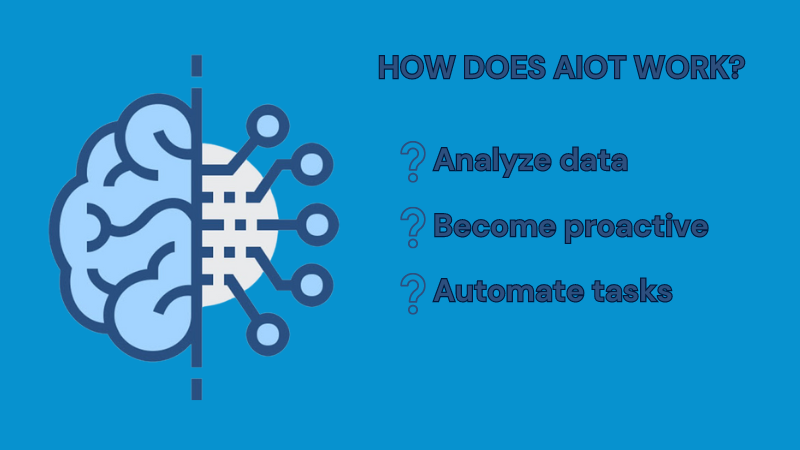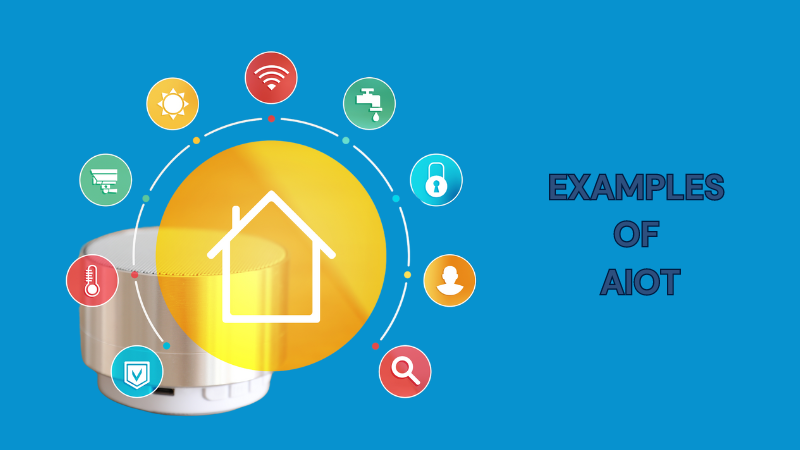AIoT, which stands for Artificial Intelligence of Things, is the merging of two powerful technologies: Artificial Intelligence (AI) and the Internet of Things (IoT)
In this article, we explain AIoT in great detail.
Aiot Meaning
AI is a branch of computer science that deals with the creation of intelligent agents, which are systems that can reason, learn, and act autonomously.
IoT refers to the network of physical devices, vehicles, home appliances, and other items embedded with electronics, software, sensors, actuators, and connectivity which allows them to collect and exchange data.
So, AIoT essentially equips IoT devices with artificial intelligence capabilities. This allows these devices to analyze the data they collect from the real world, learn from it, and even make decisions and take actions without needing constant human intervention.
How does AIoT Work?
IoT devices like sensors, appliances, and wearables gather all sorts of data from the environment – temperature readings from a smart thermostat, activity data from a fitness tracker, or even traffic flow data from sensors embedded in roads. If you want to learn more, also you can read more about how IoT works.
AI algorithms then take over. They crunch this data, identifying patterns, learning from it, and even making decisions and taking action.

Here are some key things AIoT allows these devices to do:
Analyze data. Imagine a smart factory where machines analyze sensor data to predict equipment breakdowns or a smartwatch that analyzes your sleep patterns.
Become proactive. Based on this analysis, AIoT systems can take action. The factory machine might order replacement parts before it breaks down, or your smartwatch might suggest adjusting your sleep schedule.
Automate tasks. AIoT makes repetitive tasks easy. Your coffee maker can brew a pot right as you wake up, or a lawnmower can mow the lawn independently.
In short, AIoT transforms dumb devices into smart assistants, making our lives more efficient and convenient.
Benefits and Drawbacks
Benefits of AIoT
AIoT brings several advantages that make processes smarter and more efficient.
- First, it helps in automating tasks by using AI to study data from IoT devices. This means less manual work, better use of resources, and smoother operations overall.
- Secondly, AIoT enables faster decision-making by analyzing data in real-time. This is helpful in managing things like traffic, industries, and healthcare, where quick decisions matter a lot.
- Third, it predicts when machines might break down. By analyzing data from sensors, AIoT can tell when equipment is likely to fail, allowing for repairs before anything breaks. This saves time and money.
- Fourth, it makes things more personal. For example, smart homes adjust settings like lighting and temperature based on what people prefer. Wearable devices provide personalized health tips, making technology feel more tailored to individual needs.
- Lastly, AIoT betters security by using AI to spot potential threats to IoT devices. This helps prevent hackers from causing problems or stealing information.
Drawbacks of AIoT
Despite its benefits, AIoT has some downsides too.
- One big issue is security. With so many connected devices, there’s a greater risk of hackers breaking in. If not properly protected, these systems could be vulnerable to attacks.
- Privacy is another concern. The data collected by IoT devices can be very personal, raising worries about how it’s used and protected from misuse.
- Job loss is also a worry. As AIoT automates tasks, some jobs might disappear, requiring people to find new roles or learn new skills.
- AI algorithms can also be biased, leading to unfair outcomes in AIoT applications. This is something that needs to be addressed to ensure fairness for everyone.
- Lastly, developing and using AIoT solutions can be complex and costly, making it harder for smaller businesses to adopt them.
Overall, while AIoT offers many benefits, it’s important to address these challenges to use it responsibly and make the most of its potential.
Examples of AIoT
Here are some simple examples of how AIoT (Artificial Intelligence of Things) works in different areas:
Smart Homes
Imagine your home is smart and can adjust things automatically. For example, a smart thermostat learns your temperature preferences and adjusts accordingly, saving energy.
Security cameras can distinguish between familiar faces and strangers, sending you alerts if something seems off.
Even your fridge can be smart, keeping track of what’s inside and suggesting recipes based on what you have.

Predictive Maintenance
In factories, machines have sensors that collect data. AI analyzes this data to predict when a machine might break down, so repairs can be done before it happens.
Similarly, wearable devices like fitness trackers monitor your health, and AI can warn you about potential health issues before they become serious.
Personalized Experiences
Think about your smartphone knowing what you need before you ask. AI assistants can remind you of important tasks or suggest the best route to avoid traffic.
Streaming services recommend shows based on what you like to watch. Even in stores, virtual mirrors can suggest outfits based on your style.
Other Applications
In smart cities, AIoT helps manage traffic, saves energy, and monitors air quality. Self-driving cars use AI to navigate safely on roads.
In farming, drones equipped with AI can check crops for problems like pests or diseases and help farmers make better decisions.
These examples show how AIoT makes things easier, safer, and more convenient in everyday life, with technology adapting to our needs and helping us in various ways.
Conclusion
AIoT, or Artificial Intelligence of Things, combines AI and IoT technologies to make devices smarter. It allows devices like sensors and wearables to collect data and use AI to analyze it, learn, and make decisions without human intervention.
AIoT benefits include efficiency, faster decision-making, predictive maintenance, personalized experiences, and enhanced security. But it also raises concerns like security risks, privacy issues, potential job loss, algorithmic bias, and high costs.
Overall, AIoT improves convenience and safety but requires addressing challenges like security and privacy to maximize benefits.
FAQ
1. What is AIoT❓
AIoT stands for Artificial Intelligence of Things. It’s about making everyday things smarter by combining Artificial Intelligence (AI) with Internet of Things (IoT) devices.
2. How does AIoT work❓
AIoT works by giving IoT devices the ability to collect data from their surroundings and then use AI to analyze that data, learn from it, and make decisions or take actions on their own.
3. What are the benefits of AIoT❓
AIoT brings benefits like making tasks easier through automation, making decisions faster and smarter, preventing breakdowns before they happen, giving personalized experiences, and keeping things more secure.
4. What are some examples of AIoT❓
Examples include smart homes with devices like learning thermostats and security cameras, factories that predict when machines might break down, and smartphones that understand your needs and habits.
5. What challenges does AIoT face❓
Challenges include making sure things are secure from hackers, protecting people’s privacy, dealing with potential job changes as tasks become automated, making sure decisions are fair for everyone, and managing the cost and complexity of setting up AIoT systems.
6. How can AIoT help businesses and industries❓
AIoT can help businesses by making operations smoother and more efficient, reducing downtime by predicting problems, improving customer experiences with personalized services, and making things more secure.
7. What’s next for AIoT❓
In the future, we’ll likely see even smarter devices, more ways to use AIoT in different areas like healthcare and transportation, and continued improvements in how things work and how safe they are.
8. What is AI in Internet of Things❓
AI in the Internet of Things (IoT) means using artificial intelligence in connected devices to help them make decisions and take actions on their own, without human input. It makes IoT devices smarter, enabling them to learn from data, adapt to changes, and work more efficiently.